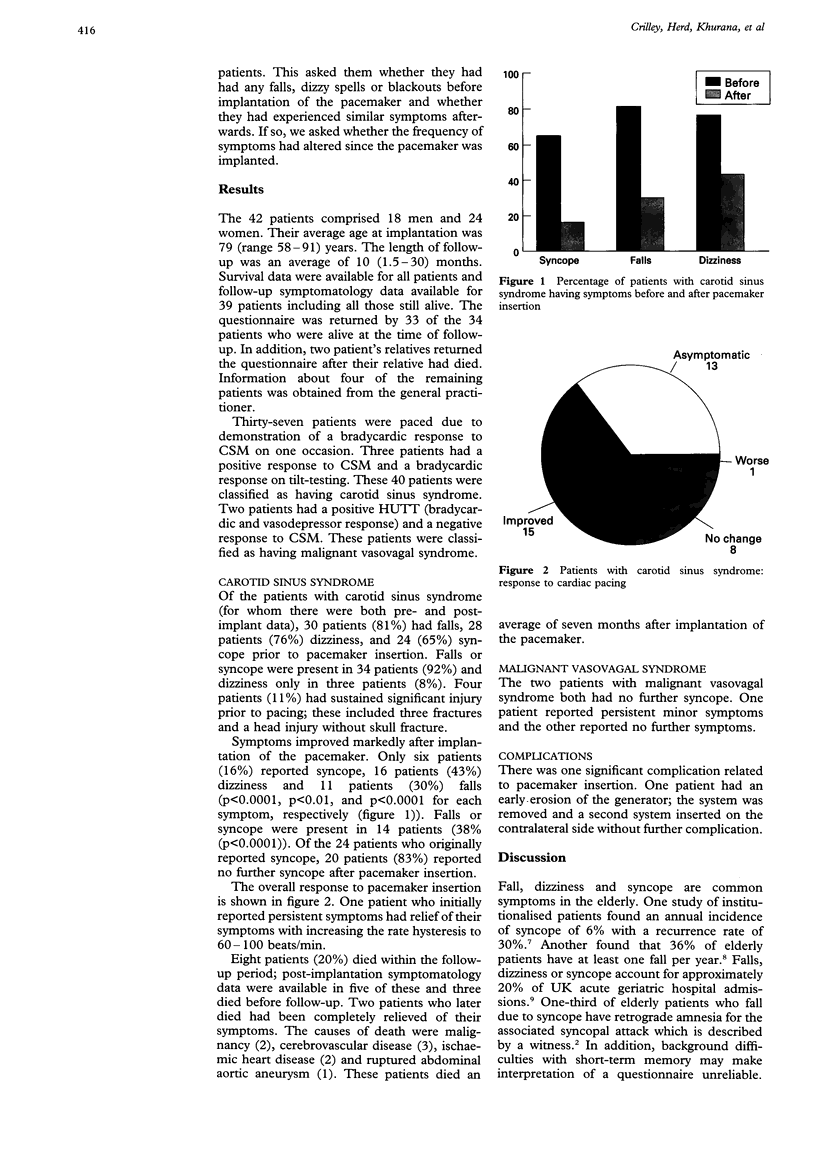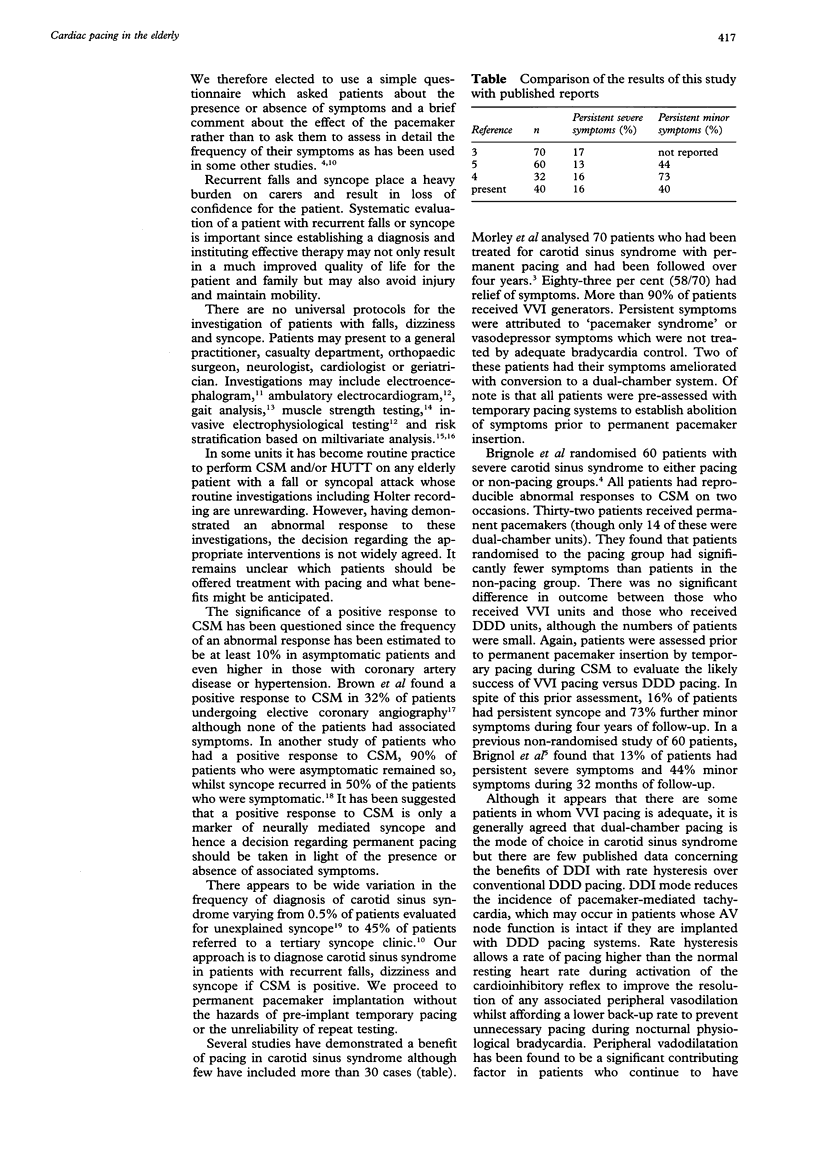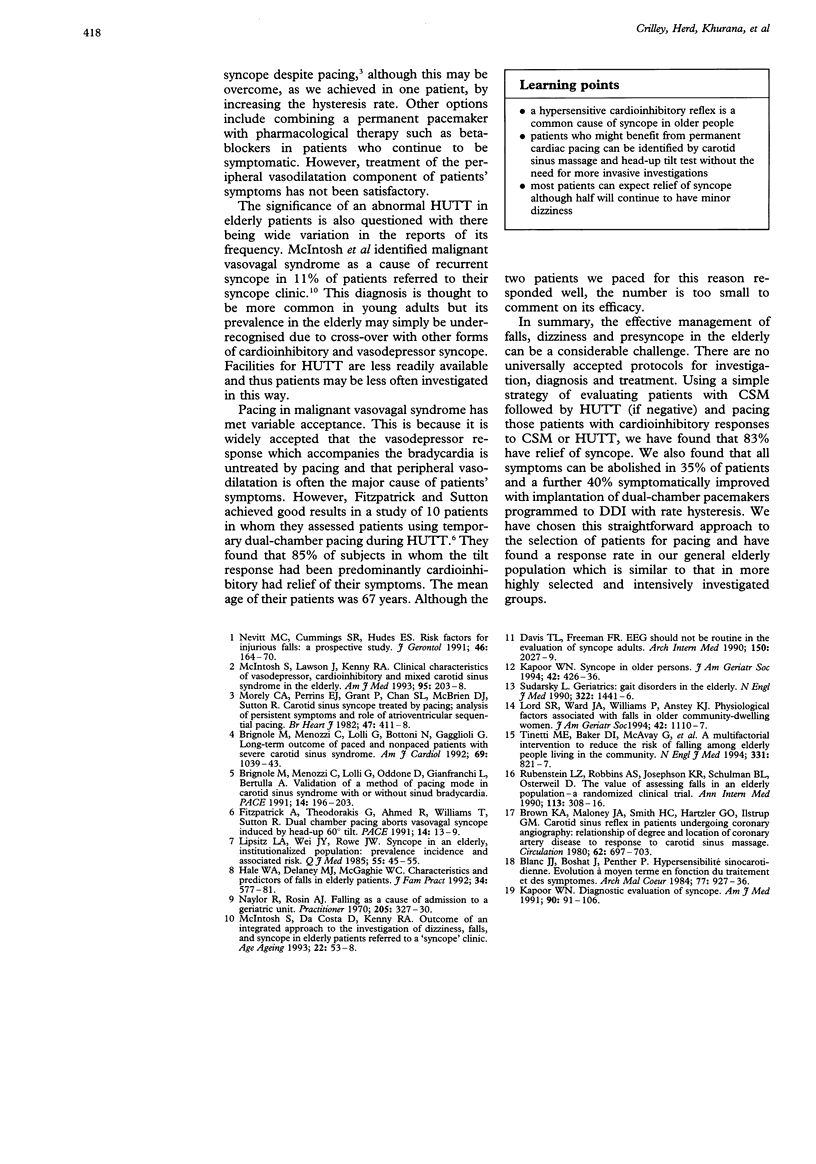Abstract
The study was designed to assess the outcome of treatment with permanent dual-chamber pacing of elderly patients with falls, dizziness and syncope associated with the demonstration of a hypersensitive cardioinhibitory reflex. Questionnaires were sent to patients (and their general practitioners) who had been referred to a regional pacing centre with recurrent falls, dizziness or syncope diagnosed as likely to be secondary to cardioinhibitory carotid sinus syndrome or predominantly cardioinhibitory vasovagal syndrome. After pacemaker insertion, 84% of patients had no further syncope over a mean follow-up period of 10 (range 1.5 to 30) months. Minor symptoms persisted in only 40% of all patients. Symptoms were unchanged in 22%. It was concluded that permanent dual-chamber pacing is an effective treatment for elderly patients with recurrent falls, dizziness and syncope in whom a hypersensitive cardioinhibitory reflex is found. Good results were obtained in this group with a simple diagnostic work-up.
Full text
PDF



Selected References
These references are in PubMed. This may not be the complete list of references from this article.
- Brignole M., Menozzi C., Lolli G., Bottoni N., Gaggioli G. Long-term outcome of paced and nonpaced patients with severe carotid sinus syndrome. Am J Cardiol. 1992 Apr 15;69(12):1039–1043. doi: 10.1016/0002-9149(92)90860-2. [DOI] [PubMed] [Google Scholar]
- Brignole M., Menozzi C., Lolli G., Oddone D., Gianfranchi L., Bertulla A. Validation of a method for choice of pacing mode in carotid sinus syndrome with or without sinus bradycardia. Pacing Clin Electrophysiol. 1991 Feb;14(2 Pt 1):196–203. doi: 10.1111/j.1540-8159.1991.tb05090.x. [DOI] [PubMed] [Google Scholar]
- Brown K. A., Maloney J. D., Smith C. H., Haritzler G. O., Ilstrup D. M. Carotid sinus reflex in patients undergoing coronary angiography: relationship of degree and location of coronary artery disease to response to carotid sinus massage. Circulation. 1980 Oct;62(4):697–703. doi: 10.1161/01.cir.62.4.697. [DOI] [PubMed] [Google Scholar]
- Davis T. L., Freemon F. R. Electroencephalography should not be routine in the evaluation of syncope in adults. Arch Intern Med. 1990 Oct;150(10):2027–2029. [PubMed] [Google Scholar]
- Fitzpatrick A., Theodorakis G., Ahmed R., Williams T., Sutton R. Dual chamber pacing aborts vasovagal syncope induced by head-up 60 degrees tilt. Pacing Clin Electrophysiol. 1991 Jan;14(1):13–19. doi: 10.1111/j.1540-8159.1991.tb04042.x. [DOI] [PubMed] [Google Scholar]
- Hale W. A., Delaney M. J., McGaghie W. C. Characteristics and predictors of falls in elderly patients. J Fam Pract. 1992 May;34(5):577–581. [PubMed] [Google Scholar]
- Kapoor W. N. Diagnostic evaluation of syncope. Am J Med. 1991 Jan;90(1):91–106. doi: 10.1016/0002-9343(91)90511-u. [DOI] [PubMed] [Google Scholar]
- Kapoor W. N. Syncope in older persons. J Am Geriatr Soc. 1994 Apr;42(4):426–436. doi: 10.1111/j.1532-5415.1994.tb07493.x. [DOI] [PubMed] [Google Scholar]
- Lipsitz L. A., Wei J. Y., Rowe J. W. Syncope in an elderly, institutionalised population: prevalence, incidence, and associated risk. Q J Med. 1985 Apr;55(216):45–54. [PubMed] [Google Scholar]
- McIntosh S. J., Lawson J., Kenny R. A. Clinical characteristics of vasodepressor, cardioinhibitory, and mixed carotid sinus syndrome in the elderly. Am J Med. 1993 Aug;95(2):203–208. doi: 10.1016/0002-9343(93)90261-m. [DOI] [PubMed] [Google Scholar]
- McIntosh S., Da Costa D., Kenny R. A. Outcome of an integrated approach to the investigation of dizziness, falls and syncope in elderly patients referred to a 'syncope' clinic. Age Ageing. 1993 Jan;22(1):53–58. doi: 10.1093/ageing/22.1.53. [DOI] [PubMed] [Google Scholar]
- Naylor R., Rosin A. J. Falling as a cause of admission to a geriatric unit. Practitioner. 1970 Sep;205(227):327–330. [PubMed] [Google Scholar]
- Rubenstein L. Z., Robbins A. S., Josephson K. R., Schulman B. L., Osterweil D. The value of assessing falls in an elderly population. A randomized clinical trial. Ann Intern Med. 1990 Aug 15;113(4):308–316. doi: 10.7326/0003-4819-113-4-308. [DOI] [PubMed] [Google Scholar]
- Sudarsky L. Geriatrics: gait disorders in the elderly. N Engl J Med. 1990 May 17;322(20):1441–1446. doi: 10.1056/NEJM199005173222007. [DOI] [PubMed] [Google Scholar]
- Tinetti M. E., Baker D. I., McAvay G., Claus E. B., Garrett P., Gottschalk M., Koch M. L., Trainor K., Horwitz R. I. A multifactorial intervention to reduce the risk of falling among elderly people living in the community. N Engl J Med. 1994 Sep 29;331(13):821–827. doi: 10.1056/NEJM199409293311301. [DOI] [PubMed] [Google Scholar]


